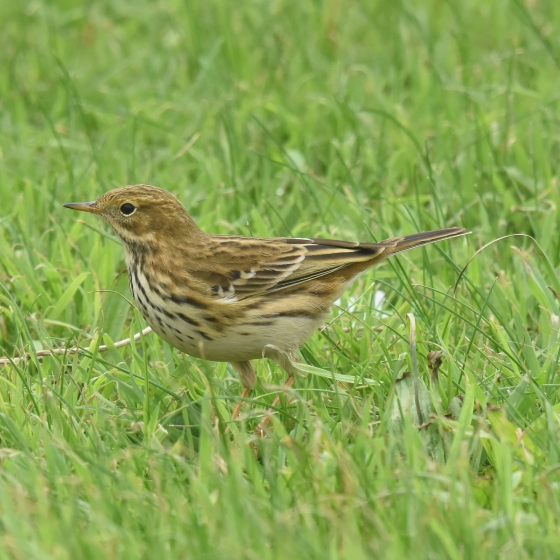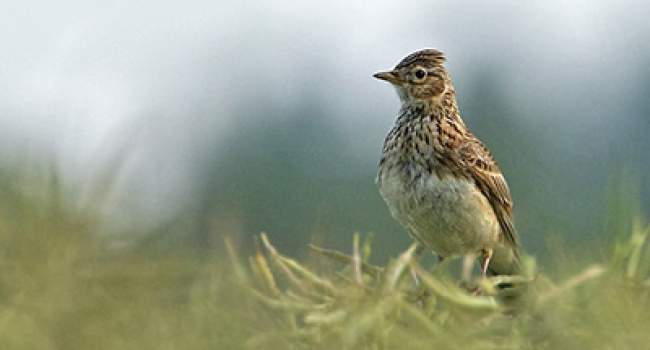Meadow Pipit
Anthus pratensis (Linnaeus, 1758)
MP
 MEAPI
MEAPI  10110
10110

Family: Passeriformes > Motacillidae

A bird of our grasslands, uplands and saltmarshes, the streaky, brown and pink-legged Meadow Pipit is easy to overlook.
The Meadow Pipit is a very common bird found across Britain & Ireland in our wilder places. It is at its most obvious during the summer when it delivers its song in a long parachuting descent. During the winter months, some of our breeding birds leave the UK for southern Europe and North Africa and in the autumn it is amongst our most visible diurnal migrants. At this time flocks of birds, thousands strong comprised of British and northern European Meadow Pipits, head south over migration watchpoints. Some Meadow Pipits that breed elsewhere in Europe also spend their winters in Britain & Ireland.
Meadow Pipits typically produce two clutches a year. Their breeding numbers have steadily declined in the UK since the mid-1970s for reasons that are not fully understood.
Exploring the trends for Meadow Pipit
Our Trends Explorer will also give you the latest insight into how the UK's Meadow Pipit population is changing.
trends explorerIdentification
Meadow Pipit identification is sometimes difficult. The following article may help when identifying Meadow Pipit.
Identifying Skylark & Woodlark

Lauded by poets for their wonderful, uplifting song, larks are rather nondescript birds when seen. There are two species regularly found in Britain and Ireland and their ranges and habitats do overlap, so how can we tell them apart?
- 1 of 3
- next ›
SONGS AND CALLS
Listen to example recordings of the main vocalisations of Meadow Pipit, provided by xeno-canto contributors.
Call
Song
Develop your bird ID skills with our training courses
Our interactive online courses are a great way to develop your bird identification skills, whether you're new to the hobby or a competent birder looking to hone your abilities.
Browse training coursesStatus and Trends
Population size and trends and patterns of distribution based on BTO surveys and atlases with data collected by BTO volunteers.
CONSERVATION STATUS
This species can be found on the following statutory and conservation listings and schedules.
POPULATION CHANGE
The CBC/BBS trend has been downward since the mid 1970s. Moorland, the key Meadow Pipit habitat, was not covered well by the CBC, leading to some doubt about the significance of the early results for this species, but BBS now provides more representative monitoring that, in England at least, confirms the picture presented by CBC. As a result of the declines, the species has accordingly been moved from the green to the amber list. The BBS map of change in relative density between 1994-96 and 2007-09 indicates that the species decreased over that period throughout the core of its UK range in Scotland, Northern Ireland and northern England but that numbers increased in some southern regions. However, more recent BBS data shows subsequent increases have occurred in Scotland (over the period 2008-2018). There has been a decline across Europe since 1980 (PECBMS: PECBMS 2020a>); see also Lehikoinen et al. 2014).
| UK breeding population |
-14% decrease (1995–2020) 
|
Exploring the trends for Meadow Pipit
Our Trends Explorer will also give you the latest insight into how the UK's Meadow Pipit population is changing.
trends explorerDISTRIBUTION
In winter, Meadow Pipits are widely distributed across Britain and Ireland with absence mostly confined to the highest ground. Densities are high throughout Ireland but in Britain high densities are largely confined to the coastal fringe and the Fens. By contrast, in the breeding season, Meadow Pipits are widespread in the north and west but patchily distributed in the southern English lowlands, with highest densities in upland areas.
Occupied 10-km squares in UK
| No. occupied in breeding season | 2741 |
| % occupied in breeding season | 91 |
| No. occupied in winter | 2804 |
| % occupied in winter | 93 |
European Distribution Map
European Breeding Bird Atlas 2
Breeding Season Habitats
| Most frequent in |
Bog, Moorland 
|
| Also common in | Grass/Heath, Marsh |
Relative frequency by habitat
Relative occurrence in different habitat types during the breeding season.

DISTRIBUTION CHANGE
Small range losses mask more signficant breeding population declines in both Britain and Ireland.
Change in occupied 10-km squares in the UK
| % change in range in breeding season (1968–72 to 2008–11) | -2% |
| % change in range in winter (1981–84 to 2007–11) | +10.3% |
SEASONALITY
Meadow Pipit is recorded throughout the year, with noticeable peaks in reporting in summer and during autumn passage; in winter can be harder to see when skulking in fields and marshes.

Movement
Information about movement and migration based on online bird portals (e.g. BirdTrack), Ringing schemes and tracking studies.
An overview of year-round movements for the whole of Europe can be seen on the EuroBirdPortal viewer.
RINGING RECOVERIES
View a summary of recoveries in the Online Ringing Report.
Foreign locations of birds ringed or recovered in Britain & Ireland

Biology
Lifecycle and body size information about Meadow Pipit, including statistics on nesting, eggs and lifespan based on BTO ringing and nest recording data.
PRODUCTIVITY & NESTING
Exploring the trends for Meadow Pipit
Our Trends Explorer will also give you the latest insight into how the UK's Meadow Pipit population is changing.
trends explorerSURVIVAL & LONGEVITY
View number ringed each year in the Online Ringing Report
Maximum Age from Ringing 
|
7 years 9 months 10 days (set in 2019) 
|
Typical Lifespan 
|
3 years with breeding typically at 1 year |
Adult Survival 
|
0.543±0.122  
|
Exploring the trends for Meadow Pipit
Our Trends Explorer will also give you the latest insight into how the UK's Meadow Pipit population is changing.
trends explorerBIOMETRICS
Wing Length 
|
Adults | 81.3±2.9 | Range 76–86mm, N=4400 |
| Juveniles | 80.9±2.8 | Range 76-85mm, N=27734 | |
| Males | 83.2±2.5 | Range 78–87mm, N=450 | |
| Females | 77.7±2.5 | Range 74–83mm, N=226 |
Body Weight 
|
Adults | 18.9±2.12 | Range 16.3–22.3g, N=3801 |
| Juveniles | 18.3±1.4149 | Range 16.1–20.7g, N=22418 | |
| Males | 19.2±1.75 | Range 16.9–22.3g, N=404 | |
| Females | 18.5±1.99 | Range 16.0–22.3g, N=202 |
Feather measurements and photos on featherbase 
CODES & CLASSIFICATION
Ring size 
|
A |
Field Codes 
|
2-letter: MP | 5-letter code: MEAPI | Euring: 10110 |
For information in another language (where available) click on a linked name
Research
Interpretation and scientific publications about Meadow Pipit from BTO scientists.
CAUSES AND SOLUTIONS
Causes of change
The causes of changes for Meadow Pipit are unclear.
Further information on causes of change
Losses of marginal land from parts of the breeding range have been linked to the decline (Gibbons et al. 1993). Changes to grazing regimes can influence breeding abundance (see Conservation Actions section, below) which could potentially have driven UK trends but this has not been proven. Nest failure rates during the chick stage have declined, which may reflect the loss of birds from suboptimal habitat. The number of fledglings per breeding attempt increased during the 1990s but has since fallen to slightly below the 1968 rate. Meadow Pipit abundance is positively correlated with soil moisture and negatively correlated with temperature (at the level of both macroclimate and microclimate) and future climate change may cause the species to become increasingly restricted to suitable areas on cooler slopes (Massimino et al. 2020); whilst this study did not examine past declines it is feasible therefore that climate change could also have contributed at least partly to the observed declines.
Meadow Pipits are partial migrants and it has also been suggested that conditions on the Iberian wintering grounds may also have contributed to the declines (Gibbons et al. 1993).
Information about conservation actions
The Meadow Pipit has been declining since the mid 1970s and the causes of this decline are unclear.
Experiments in central Scotland (Evans et al. 2006; Vandenberghe et al. 2009; Malm et al. 2020) have shown that Meadow Pipit breeding abundance can be improved by reduced grazing intensity and by mixing cattle and sheep, which provides better foraging conditions than intensive sheep-dominated grazing regimes, and improves breeding productivity.
Preventing or reducing losses of marginal land in upland areas (to intensive sheep farming or other uses) will also help ensure suitable habitat continues to be available to Meadow Pipits. Conservation management to create the optimum habitat in UK uplands should aim to provide a mosaic of heather, bog and grassland (Vanhinsberg & Chamberlain 2001). Meadow Pipit density declines at higher levels of heather cover, but increases with grass cover (Smith et al. 2001). Pipit density reaches a maximum when grass covers between 40% and 60% of a 1 km square (Vanhinsberg & Chamberlain 2001).
Focusing future habitat protection and management actions towards areas of suitable habitat on the cooler slopes of upland areas should also be considered where practical as this may help buffer Meadow Pipits and other upland species against the possible future effects of climate change (Massimino et al. 2020)
Links to more information from ConservationEvidence.com
Would you like to search for another species?












Share this page